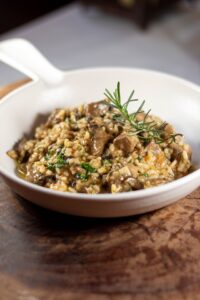In Ayurveda, pizza as some of the most dreaded dishes as the combination of sour tomatoes, salty cheese and the yeast in the dough are highly imbalancing for all 3 doshas!
Many ayurveda patients still like to have their weekly treat and find it hard to give up pizza completely.
Thankfully Yoga teacher Lisa B. (@healthyandcrunchy), shares with us her own variation of a pitta balancing pizza. (+ I’ve added some suggestions to suit other constitutions).

Now your turn to experiment! Review Lisa’s pitta balancing pizza, try it, adjust it, taste it, observe how you feel when/after eating it, and make it your own according to your individual constitution (to find out your constitution take the test here)
Ingredients
For the crust:
2 cups chickpea flour ( – Vata constitutions can opt for emmer wheat or rice flour – heavier, less dry)
1 cup of water
2 tablespoons of virgin olive oil ( – Vata constitutions can opt for ghee to add moisture)
rock salt, pepper
1 tsp. fennel seed powder ( – Vata / manda agni – weak digestion – constitutions can add a pinch of cumin too)
For the wild garlic pesto:
100 g wild garlic ( – not as heavy or pungent as regular garlic cloves – high pitta/vata though can steam or roast the wild garlic to make it sweeter, less pungent)
30 g of pine nuts ( – high pitta may opt for almonds – cooling, less oily)
3 cl virgin olive oil
30 g pecorino cheese (or parmesan or 2 tbsp nutritional yeast for a vegan version)
rock salt, pepper
2 tablespoons of water
TIP #1: Lisa suggests preparing an avocado pesto for when the wild garlic season is over. That is also a great option for pitta/vata to bring some cooling and unctuosity to the dish and balance its natural dryness.
TIP #2: If there is any pesto left over, store it in a small glass jar, airtight, in a cool place, cook some pasta al dente, and add the pesto, or freeze it for a future recipe.
For the Spring topping:
4 or 5 green asparagus spears cut in half
a handful of fresh peas (- can be delicate for vata to digest, make sure they are well cooked)
½ zucchini (- more zucchini for vata/pitta and less for kapha due to high moisture content)
3 nice handfuls of arugula (- for vata or those with manda agni – weak digestion – precook with a little oil, lime and rock salt)
a few pink radishes
1 small bulb of raw fennel
juice of a lime
olive oil
a few pine nuts, lightly toasted ( – high pitta may opt for almonds)
a few kalamata olives (- pitta/kapha can reduce olives which are sour and heating)
Method
- Preheat oven to 200C.
- In a bowl, mix the chickpea flour with the olive oil, water, fennel powder, salt and pepper until you obtain a homogeneous and slightly sticky dough.
- Pour the mixture onto a silicone baking sheet or a round pan lined with baking paper and bake for about 20 minutes.
- Wash the wild garlic leaves and remove the bottom of the stem. Put them in the bowl of a blender with the rest of the ingredients.
- Blend until smooth, adding a little more water if necessary.
- Cut the fennel bulb, the radishes and the zucchini with a mandolin.
- Steam the asparagus and peas for 10 minutes, then add the zucchini ribbons to the sieve for only 1 to 2 minutes.
- Wash the arugula thoroughly (- Vatas or kapha with manda (weak) agni place in a bowl and pre-cook with a little lime, rock salt and olive oil)
- Once the pizza is out of the oven, wait for it to cool, pour the pesto evenly over it and place the “spring topping” on top.
- Add a drizzle of olive oil and a squeeze of lemon juice before enjoying the pizza.
Enjoy your home made healthy pitta balancing pizza with family and friends ! ????







